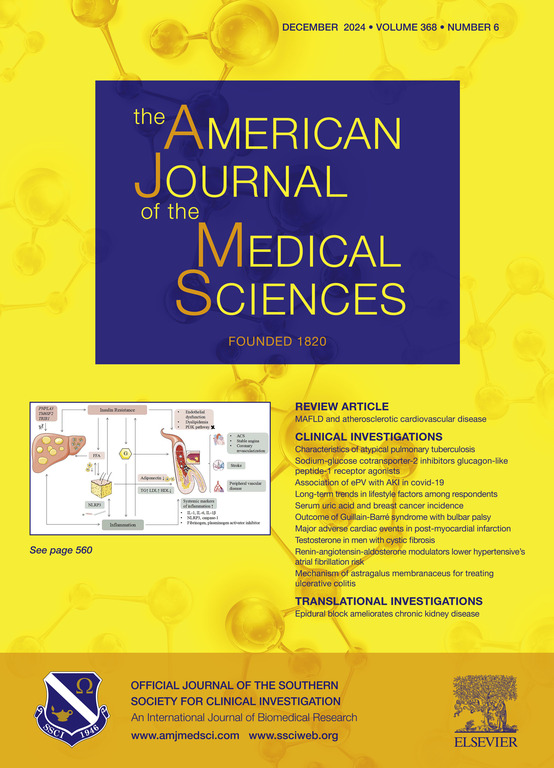(-) - Epicatechin regulates LOC107986454 by targeting the miR-143–3p/EZH2 axis to enhance the radiosensitivity of non-small cell lung cancer
IF 1.8
4区 医学
Q2 MEDICINE, GENERAL & INTERNAL
引用次数: 0
Abstract
Background and objective
Non-small cell lung cancer (NSCLC) is a pernicious tumor with high incidence and mortality rates. The incidence rate of NSCLC increases with age and poses a serious danger to human health. The aim of this study was to determine the mechanism by which (-)-epicatechin (EC) alleviates NSCLC.
Methods
Twenty-four pairs of NSCLC tissues and cancer-adjacent tissues were collected, and A549 and H460 radiotherapy-resistant strains were generated by repeatedly irradiating A549 and H460 cells with dose-gradient X-rays. Radiotherapy-resistant H460 cells were successfully injected subcutaneously into the left dorsal side of nude mice at a dose of 1 × 105 to establish an NSCLC animal model. The levels of interrelated genes and proteins were detected by RT‒qPCR and Western blotting, and cell proliferation and apoptosis were evaluated by CCK‒8 assay, Transwell assay, flow cytometry, and TUNEL staining.
Results
LOC107986454 was highly expressed in NSCLC patients, while miR-143–3p was expressed at low levels and was negatively correlated with LOC107986454. Functionally, EC promoted autophagy and apoptosis induced by radiotherapy, restrained cell proliferation and migration, and ultimately enhanced the radiosensitivity of NSCLC cells. A downstream mechanistic study showed that EC facilitated miR-143–3p expression by inhibiting LOC107986454 and then restraining the expression of EZH2, which ultimately facilitated autophagy and apoptosis in cancer cells, inhibited proliferation and migration, and enhanced the radiosensitivity of NSCLC cells.
Conclusion
EC can enhance the radiosensitivity of NSCLC cells by regulating the LOC107986454/miR-143–3p/EZH2 axis.
(-) - 表儿茶素通过靶向 miR-143-3p/EZH2 轴来调节 LOC107986454,从而增强非小细胞肺癌的放射敏感性。
背景和目的:非小细胞肺癌(NSCLC)是一种发病率和死亡率都很高的恶性肿瘤。非小细胞肺癌的发病率随着年龄的增长而增加,严重危害人类健康。本研究旨在确定(-)-表儿茶素(EC)缓解NSCLC的机制:方法:收集24对NSCLC组织和癌邻近组织,用剂量梯度X射线反复照射A549和H460细胞,产生A549和H460放疗耐药株。成功地将放疗耐药的H460细胞以1×105的剂量皮下注射到裸鼠的左背侧,建立了NSCLC动物模型。通过RT-qPCR和Western印迹法检测了相关基因和蛋白质的水平,并通过CCK-8检测法、Transwell检测法、流式细胞术和TUNEL染色法评估了细胞的增殖和凋亡:结果:LOC107986454在NSCLC患者中高表达,而miR-143-3p低表达,且与LOC107986454呈负相关。在功能上,EC能促进放疗诱导的自噬和凋亡,抑制细胞增殖和迁移,最终增强NSCLC细胞的放射敏感性。下游机理研究表明,EC通过抑制LOC107986454促进miR-143-3p的表达,进而抑制EZH2的表达,最终促进癌细胞的自噬和凋亡,抑制细胞的增殖和迁移,增强NSCLC细胞的放射敏感性:结论:EC可通过调节LOC107986454/miR-143-3p/EZH2轴增强NSCLC细胞的放射敏感性。
本文章由计算机程序翻译,如有差异,请以英文原文为准。
求助全文
约1分钟内获得全文
求助全文
来源期刊
CiteScore
4.40
自引率
0.00%
发文量
303
审稿时长
1.5 months
期刊介绍:
The American Journal of The Medical Sciences (AJMS), founded in 1820, is the 2nd oldest medical journal in the United States. The AJMS is the official journal of the Southern Society for Clinical Investigation (SSCI). The SSCI is dedicated to the advancement of medical research and the exchange of knowledge, information and ideas. Its members are committed to mentoring future generations of medical investigators and promoting careers in academic medicine. The AJMS publishes, on a monthly basis, peer-reviewed articles in the field of internal medicine and its subspecialties, which include:
Original clinical and basic science investigations
Review articles
Online Images in the Medical Sciences
Special Features Include:
Patient-Centered Focused Reviews
History of Medicine
The Science of Medical Education.

 求助内容:
求助内容: 应助结果提醒方式:
应助结果提醒方式:


